Steinberg Wavelab Elements - 10.0 Operation Manual
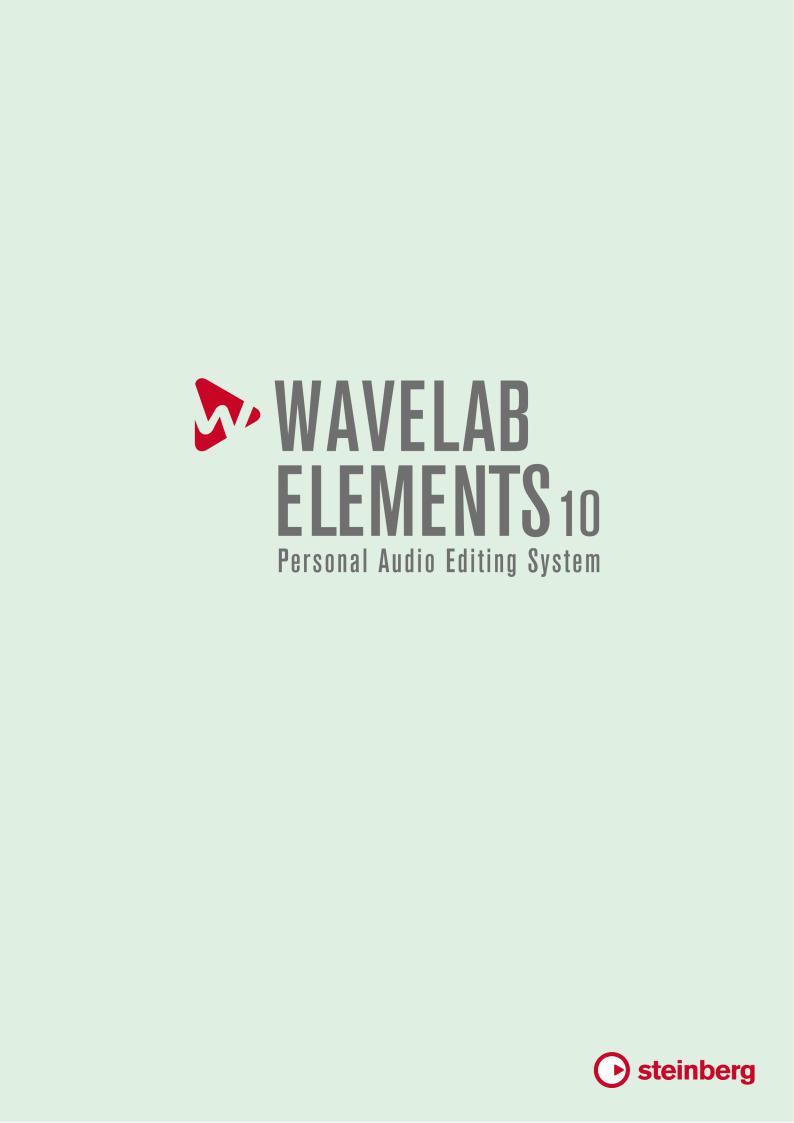
Operation Manual
Cristina Bachmann, Heiko Bischoff, Lillie Harris, Christina Kaboth, Insa Mingers, Matthias Obrecht, Sabine Pfeifer, Benjamin Schütte, Marita Sladek
This PDF provides improved access for vision-impaired users. Please note that due to the complexity and number of images in this document, it is not possible to include text descriptions of images.
The information in this document is subject to change without notice and does not represent a commitment on the part of Steinberg Media Technologies GmbH. The software described by this document is subject to a License Agreement and may not be copied to other media except as specifically allowed in the License Agreement. No part of this publication may be copied, reproduced, or otherwise transmitted or recorded, for any purpose, without prior written permission by Steinberg Media Technologies GmbH. Registered licensees of the product described herein may print one copy of this document for their personal use.
All product and company names are ™ or ® trademarks of their respective owners. For more information, please visit www.steinberg.net/trademarks.
© Steinberg Media Technologies GmbH, 2019. All rights reserved.
WaveLab Elements_10.0.0_en-US_2019-10-15

Table of Contents
5New Features
7WaveLab Elements Introduction
7Platform-Independent Documentation
7Help System
8Conventions
9Key Commands
10 Setting Up Your System
10 Connecting the Equipment
10 Audio Cards and Background Playback
10Latency
11ASIO-Guard
11 Defining Audio Connections
14 CD/DVD Recorders
14 Remote Devices
19WaveLab Elements Concepts
19General Editing Rules
19Startup Dialog
20Basic Window Handling
20 |
Selecting Audio |
24 |
Sliders |
24 |
Renaming Items in Tables |
24 |
File Browser |
26Tab Groups
27Peak Files
28Companion Files
28 Processing Precision
30Workspace Window
30Audio Editor
30Audio Montage
31Podcast Editor
31File Tab
32Info Tab
34Tool Windows
34Meter Windows
34Slide-Out Windows
35Docking and Undocking Tool Windows and Meter Windows
36Command Bar
37Status Bar
38Context Menus
39Time Ruler and Level Ruler
42Managing Tabs
43Activating Full Screen Mode
43Resetting the Default Workspace Layout
44Project Handling
44Opening Files
45Value Editing
45Drag Operations
46 Undoing and Redoing
49 Zooming in the Workspace Window
54 Presets
56File Operations
56Recently Used Files
57Save and Save As
59 Templates
63File Renaming
63Deleting Files
63Temporary Files
64Work Folders vs. Document Folders
66Copying Audio Information to the Clipboard
66Setting the Focus on the Current File
67Playback
67 Transport Bar
76Starting Playback From the Ruler
77Playback Scrubbing
78Scroll During Playback
78Playback in the Audio Montage Window
79Audio File Editing
79 Wave Window
83 Audio Editor Tabs
90 File Handling in the Audio Editor
108 Changing the Audio Properties
108 Metadata
111 Mixing Down – Audio Files Rendering
111 Silence Generator Dialog
113Bleep Censor
114Waveform Restoration with the Pen Tool
115Audio Analysis
115 Global Analysis
122 3D Frequency Analysis
125 Offline Processing
125 Process Tab
127Applying Processing
127Gain Dialog
127Level Normalizer Dialog
128Envelope Dialog
129Fades in Audio Files
130Crossfades
131Phase Inverting
131Reversing Audio
132DC Offset
132 Time Stretching
134Pitch Shift
135Resample
136Audio Montage
136Montage Window
3

Table of Contents
140 Audio Montage Tabs
147Signal Path in the Audio Montage
148Creating New Audio Montages
148Audio Montage Duplicates
149Creating an Audio Montage from an Audio File
149Import Options for Audio Montages
150Missing Files Dialog
151Assembling the Audio Montage
155 Rearranging Clips
157 Clip Editing
162 Track Activity Indicator
162 Envelopes for Clips
165 Fades and Crossfades in Audio Montages
168Effects for Tracks, Clips, and the Montage Output
176 CD Window
179 Mixing Down – The Render Function
179 Loudness Meta Normalizer
181 Notes Window
181Importing a Basic Audio CDs
182Recording
182Setting Up the Recording Dialog
183Dropping Markers During Recording
183Recording Dialog
188 Master Section
188 Bypassing the Master Section
188 Master Section Window
197 Rendering
201 Saving Master Section Presets
204Monitoring Background Tasks
205Dropouts
206Markers
206Marker Types
207Markers Window
209Creating Markers
210Deleting Markers
210Moving Markers
210Navigating to Markers
211Hiding Markers of a Specific Type
211Converting Marker Types
211Renaming Markers
212Selecting Markers
212Selecting the Audio Between Markers
212Binding Markers to Clips in the Audio Montage
213How Marker Information is Saved
214 |
Metering |
214 |
Meter Windows |
214 |
Meter Settings |
214 |
Resetting the Meters |
214 |
Level Meter |
216 |
Spectroscope |
216 |
Oscilloscope |
218Writing Operations
218Write Audio CD Dialog
219Erase Optical Media Dialog
220Write Audio Montages
222Data CD/DVD Projects
225Audio CD Formats
228 Loops
228Basic Looping
229Loop Refinement
236 Looping Audio Which Is Not Very Well Suited
for Looping
239 Sample Attributes
241 Importing Audio CD Tracks
241 Import Audio CD Dialog
244Importing Audio CD Tracks
245Searching Track Names on the Internet
245Submitting Track Names to the Internet
246Ultra-Safe Mode
246Converting Audio CD Tracks to an Audio Montage
247Video
247Video Track
248Video Clip Editing
249Video Window
250Video File Compatibility
250Frame Rates
253 WaveLab Exchange
253WaveLab Elements as External Editor for Cubase/Nuendo
254Cubase/Nuendo as External Editor for WaveLab Elements
255Podcasts
255 Podcast Editor
259Global Podcast Options
259Creating a Podcast
260Setting Up a FTP for Podcast Publishing
260Publishing Podcasts
260FTP Settings Dialog
261Checking the Podcast
262Customizing
262Customizing the Wave Window and the Montage Window
263Customizing Shortcuts
267 Customizing Command Bars
267 Plug-in Organization
274Touch Bar (macOS only)
275Configuring WaveLab Elements
275Global Preferences
279Audio Files Preferences
283Audio Montages Preferences
286Synchronizing WaveLab Elements Settings on Several Computers
286Multi-User Settings
288 Index
4

New Features
New Features in Version 10.0.0
Highlights
History Window for Audio Files
●The Audio Editor now also has a History window. This allows you to see all versions of the audio file that you are working on. You can restore previous versions. See History Window for Audio Files.
Inspector Window
●This window allows you to add effect plug-ins to tracks, clips, and the montage output. The Inspector replaces the Effects window. See Inspector Window.
Video
●WaveLab Elements supports the integration of video files in your project. See Video.
More New Features
Track Control Area Redesign
●The track control area offers several new navigation options and other settings. See Track Control Area.
Resizing Tracks
●You can now freely resize the track height and width in the montage window. See Resizing Tracks.
Number of Effect Plug-ins in the Master Section Increased
●You can now add 8 effect plug-ins to the Effects pane in the Master Section. See Effects Pane.
File Browser Preview
●In the File Browser window, you can now listen to the selected audio file from any position by clicking the waveform in the Preview area. If the audio file contains markers, the markers are displayed in the preview waveform. See File Browser Window.
Audio-Processing Load
●The Audio-Processing Load display shows the average audio-processing load of plug-ins during playback. This allows you to monitor the number of plug-ins you can use. See AudioProcessing Load.
Using Undo/Redo after Saving Audio Files
●When you save audio files, the history is no longer deleted. Now you can use undo/redo even after saving audio files. See Saving an Audio File.
5

New Features
Additional ID3-v2 Metadata
●Now you can add the metadata TCMP (Part of a compilation) to your audio file. See Metadata Dialog.
Follow Playback in the CD Window
●This option allows you to see the CD track that is played back from within the CD window. See CD Window.
Follow Playback in the Markers Window
●This option allows you to see the marker that is played back from within the Markers window. See Markers Window.
6

WaveLab Elements
Introduction
Platform-Independent Documentation
The documentation applies to the operating systems Windows and macOS.
Features and settings that are specific to one of these platforms are clearly indicated. In all other cases, the descriptions and procedures in the documentation are valid for Windows and macOS.
Some points to consider:
●The screenshots are taken from Windows.
●Some functions that are available on the File menu on Windows can be found in the program name menu on macOS.
Help System
There are several ways of accessing the help system. The documentation is available online and you can download most of it in PDF format from steinberg.help.
Documentation
The documentation consists of several documents.
To visit steinberg.help, do one of the following:
●Enter www.steinberg.help in the address bar of your web browser.
●In the program, select Help > steinberg.help.
●Windows: To open the help for an active dialog on steinberg.help, click the question mark icon on the title bar to show the Help button and click the Help button, or press F1.
●macOS: To open the help for an active dialog on steinberg.help, click the question mark icon in the dialog to show the Help button and click the Help button, or press Cmd-?.
Operation Manual
The main WaveLab Elements reference documentation, with detailed descriptions of operations, parameters, functions, and techniques.
Plug-in Reference
Describes the features and parameters of the included plug-ins.
Scripting
Describes the objects and functions you can call in a WaveLab Elements script.
DDP Player
Describes the features and functions of the included DDP Player.
7

WaveLab Elements Introduction
Conventions
Tooltips
●To show tooltips, move the mouse over an interface icon.
●To use the menu help, move the mouse over a menu item.
●To see information on what kind of editing can be performed when using the mouse and modifier keys in the Audio Montage window, move the mouse over the montage window. The help text is displayed on the info line at the bottom of the window.
What’s This
The What’s This help provides extended tooltips about interface icons and functions. Some What’s This tooltips include a link to a dedicated help topic on steinberg.help.
To open the What’s This help, do one of the following:
●In any window, press Shift-F1 and move the mouse over an interface item, or select Help >
What’s This?.
●In a dialog, select the question mark icon on any title bar (Windows) or in the dialog (macOS), and move the mouse over an interface item or a menu option.
RELATED LINKS
Info Line on page 155
Conventions
In our documentation, we use typographical and markup elements to structure information.
Typographical Elements
The following typographical elements mark the following purposes.
Prerequisite
Requires you to complete an action or to fulfill a condition before starting a procedure.
Procedure
Lists the steps that you must take to achieve a specific result.
Important
Informs you about issues that might affect the system, the connected hardware, or that might bring a risk of data loss.
Note
Informs you about issues that you should consider.
Tip
Adds further information or useful suggestions.
Example
Provides you with an example.
Result
Shows the result of the procedure.
After Completing This Task
Informs you about actions or tasks that you can perform after completing the procedure.
8

WaveLab Elements Introduction
Key Commands
Related Links
Lists related topics that you can find in this documentation.
Markup
Bold text indicates the name of a menu, option, function, dialog, window, etc.
EXAMPLE
To open the Metadata dialog, open the Metadata window and click Edit.
If bold text is separated by a greater-than symbol, this indicates a sequence of different menus to open.
EXAMPLE
Select File > Open.
Key Commands
Many of the default key commands, also known as keyboard shortcuts, use modifier keys, some of which are different depending on the operating system.
When key commands with modifier keys are described in this manual, they are indicated with the Windows modifier key first, followed by the macOS modifier key and the key.
EXAMPLE
Ctrl/Cmd-Z means: press Ctrl on Windows or Cmd on macOS, then press Z.
9

Setting Up Your System
Before you start working, you need to make some settings.
IMPORTANT
Make sure that all equipment is turned off before making any connections.
Connecting the Equipment
Your system setup depends on many different factors, for example, the kind of project that you want to create, the external equipment that you want to use, or the computer hardware available to you.
Audio Cards and Background Playback
When you activate playback or recording in WaveLab Elements, other applications cannot access the audio card. Likewise, if another application uses the audio card, WaveLab Elements is unable to play back.
You can run WaveLab Elements together with other applications and always give the active application access to the audio card.
PROCEDURE
1.Select File > Preferences > Audio Connections.
2.Select the Options tab.
3.Activate Release Driver.
4.Do one of the following:
●If you want to release the driver when WaveLab Elements is in the background, activate When WaveLab Elements is in Background.
●If you want to release the driver only when Cubase is in the foreground, activate
When Cubase is in Foreground.
Latency
Latency is the delay between when audio is sent from the program and when you actually hear it. While a very low latency can be crucial in a real-time DAW application such as Steinberg Nuendo or Cubase, this is not strictly the case with WaveLab Elements.
When working with WaveLab Elements, the important issues are optimum and stable playback and editing precision.
The latency in an audio system depends on the audio hardware, its drivers, and settings. In case of dropouts, crackles, or glitches during playback, raise the ASIO-Guard setting on the Options
10

Setting Up Your System
ASIO-Guard
tab in the Audio Connections, or increase the buffer size in the ASIO control panel, specific to the audio card.
RELATED LINKS
Audio Connections Tab on page 12
ASIO-Guard
The ASIO-Guard allows you to pre-process all channels as well as VST plug-ins. This causes fewer dropouts and allows you to process more tracks or plug-ins.
High ASIO-Guard levels cause an increased ASIO-Guard latency. When you adjust a volume fader, for example, you hear parameter changes with a slight delay.
NOTE
Resampler plug-ins and certain other plug-ins with high latencies accumulate samples before processing them. This requires a higher ASIO-Guard setting.
RELATED LINKS
Setting up ASIO-Guard on page 11
Setting up ASIO-Guard
You can specify the length of the ASIO-Guard buffer.
PROCEDURE
1.Select File > Preferences > Audio Connections.
2.Click the Options tab.
3.In the ASIO-Guard menu, specify the length of the ASIO-Guard buffer.
The higher the level, the higher the processing stability and audio processing performance. However, higher levels also lead to an increased ASIO-Guard latency and memory usage.
RELATED LINKS
Audio Connections Tab on page 12
Defining Audio Connections
To be able to play back and record audio in WaveLab Elements, you must specify how the internal input and output channels in WaveLab Elements are connected to your sound card and which device you intend to use for audio playback and recording.
You can define the buffer settings for your device as well as set up connections to external effects. You should select at least two channels for stereo playback and recording.
If you have no third-party audio card, you can select the Generic Low Latency driver or Built-in Audio (Mac) options. You can also use the Generic Low Latency driver with most third-party audio cards, with the advantage that you can record and play at different sample rates.
RELATED LINKS
Audio Connections Tab on page 12
11
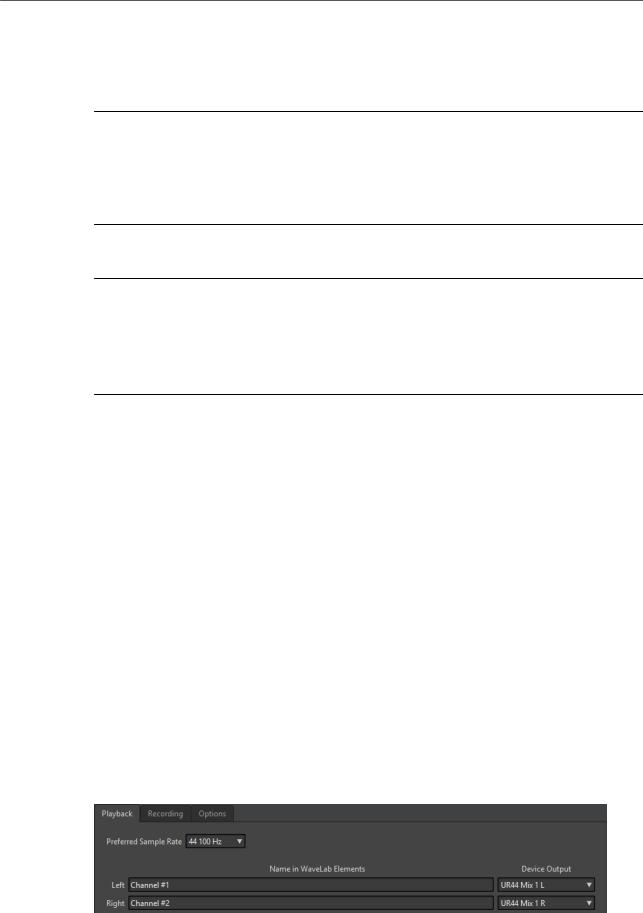
Setting Up Your System
Defining Audio Connections
Selecting an ASIO Driver
Audio Stream Input/Output (ASIO) is a computer device driver protocol for digital audio specified by Steinberg. It provides a low-latency and high fidelity interface between a software application and the soundcard of a computer.
PROCEDURE
1.Select File > Preferences > Audio Connections.
2.Open the Audio Device pop-up menu and select your ASIO driver. The ASIO Plug-ins tab and the Control Panel button are activated.
3.Optional: Click Control Panel and make your settings.
Selecting the Generic Low Latency Driver
PROCEDURE
1.Select File > Options > Audio Connections.
2.Open the Audio Device pop-up menu and select Generic Low Latency.
3.On the Playback tab, select the audio ports that are used for playback.
4.On the Recording tab, select the audio ports that used for recording and monitor input.
Audio Connections Tab
This tab allows you to specify how the internal input and output buses in WaveLab Elements are connected to your sound card and which device you want to use for audio playback and recording.
●To open the Audio Connections tab, select File > Preferences > Audio Connections.
Global Settings
Audio Device
Allows you to select the audio device that you want to use for playback and recording audio. If you do not have a third-party audio card, you can select the Generic Low Latency driver or Built-in Audio (Mac) options.
Control Panel
When you select an ASIO driver, the Control Panel button is activated. Click the button to open the settings application of your sound card, which is usually installed with the sound card. Depending on your sound card and driver, this provides settings for buffer size, digital formats, additional I/O connections, etc.
Refresh
This button causes audio devices to be evaluated again to reflect device changes.
Playback Tab
12

Setting Up Your System
Defining Audio Connections
This tab allows you to select buses that are used for playback.
Recording Tab
This tab allows you to select buses that are used for recording.
Options Tab
This tab allows you to specify the number of buffers and the control driver functionality.
ASIO-Guard
Increasing this value improves the elasticity of audio streaming to avoid dropouts. The higher the level, the higher the processing stability and audio processing performance. However, higher levels also lead to an increased ASIO-Guard latency and memory usage.
MME Specific – Buffer Size
Increasing this value improves the elasticity of audio streaming to avoid dropouts. This is only available when an MME driver is selected.
Perform Short Fade In When Starting Playback
If this option is activated, a short fade in is performed when you start playback. This avoids clicks caused by waveforms that do not start on a zero-crossing point.
Perform Short Fade Out When Stopping Playback
If this option is activated, a short fade out is performed when you stop playback. This avoids clicks caused by waveforms that do not end on a zero-crossing point. This also discards any audio signal that is caused by latency and any tail that is caused by reverb plug-ins.
Release Driver
Allows you to run WaveLab Elements together with other applications and always give the active application access to the audio card.
●If When WaveLab Elements is in Background is activated, the driver is released when WaveLab Elements is in the background.
●If When Cubase/Nuendo is in Foreground is activated, the driver is released when Cubase/Nuendo is in the foreground.
Preferred Sample Rate
Allows you to specify the Preferred Sample Rate for playback.
RELATED LINKS
ASIO-Guard on page 11
13
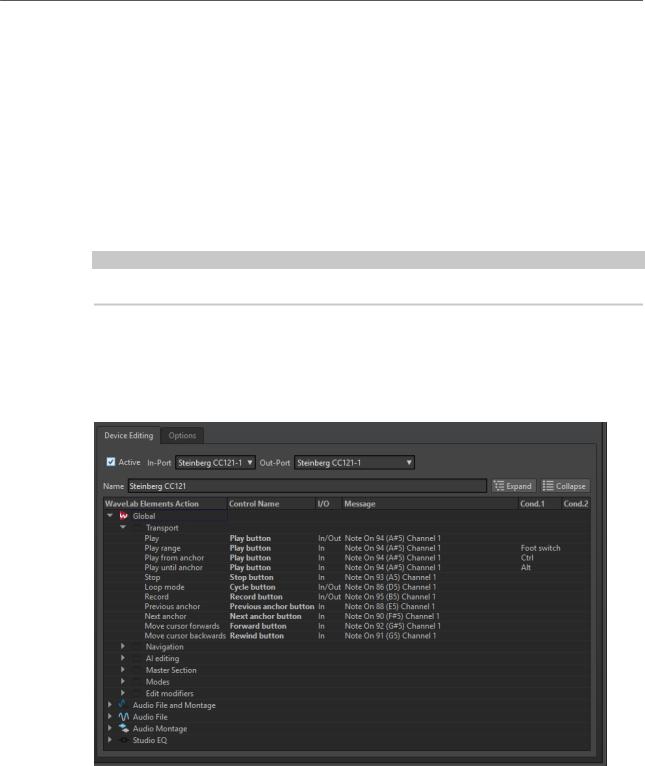
Setting Up Your System
CD/DVD Recorders
CD/DVD Recorders
For general instructions on installing internal or connecting external recorders via USB or Firewire, refer to the instruction manual for your computer or your recorder.
Make sure to have the latest firmware version installed on your recorder unit. For CD recorders, the existing firmware must support disc-at-once mode. In addition, running a unit with older firmware can prevent you from writing sub-index markers into the tracks, for example.
Remote Devices
You can use Steinberg remote devices to remote-control WaveLab Elements.
Several commands can be controlled with knobs and sliders of your remote control device.
NOTE
Only remote devices from Steinberg are supported.
Remote Devices Tab
This tab allows you to select a Steinberg device to remote-control WaveLab Elements, and see the control map of MIDI control devices.
●To open the Remote Devices tab, select File > Preferences > Remote Devices.
Device Editing Tab
This tab lets you select a MIDI control device and see the control map.
Active
Activates the selected device and scans the MIDI ports.
In-Port/Out-Port
Select the MIDI input/output ports of the device that you want to use.
14

Setting Up Your System
Remote Devices
Name
Lets you enter a map name.
Expand/Collapse
Expands/collapses the folder tree of the control map.
WaveLab Elements Action List
This folder tree lists the parameters that you can remote-control. The top folder represents contexts. The related parameters can only be controlled if the context is active. For example, if an audio file is active.
A remote control can be used in several contexts if these are exclusive. For example, parameters that can be used for an active audio file or an active audio montage.
The Global folder contains the parameters that can always be controlled.
Options Tab
Emulate Mouse Wheel
If this option is activated, the AI knob of Steinberg controllers acts as a mouse wheel in the WaveLab Elements user interface, except for plug-ins.
Edit Focused Numeric Field
If this option is activated, the AI knob Steinberg controllers can be used to edit the focused numeric field that you find in many WaveLab Elements windows and dialogs.
CC121 Advanced Integration Controller
You can use Steinberg’s CC121 Advanced Integration Controller to control WaveLab Elements.
This section describes the WaveLab Elements factory preset for the CC121. For detailed information on how to use the controller, refer to the manual that came with the CC121. Note that the CC121 was originally designed for Cubase. The following mapping combines the WaveLab Elements functionality with the CC121 controls. The controls that are not listed in the following paragraph are not assigned to a parameter.
Channel Section
You can use all controls of the CC121 channel section, except the fader, to control the elements of the selected track in a WaveLab Elements audio montage. You can use the fader for the
Master Section.
Fader
Controls the Master Section fader.
PAN knob
Controls the gain of the selected track.
Mute
Mutes/Unmutes the selected track.
Solo
Activates/Deactivates solo for the selected track.
CHANNEL SELECT
Selects the previous/next track in the audio montage.
To move the cursor to the previous/next clip edge in the audio montage, hold Alt. To move the cursor to the previous/next region edge, hold Shift. To move the cursor to the previous/next marker in the Audio Editor, hold Ctrl/Cmd.
15

Setting Up Your System
Remote Devices
EQ Section
With the EQ section you can easily control the Steinberg Studio EQ plug-in.
If EQ TYPE is activated on the CC121, you can adjust the parameters of the focused Studio-EQ. All necessary EQ parameters, such as Q/F/G of each band, EQ TYPE selection, and ALL BYPASS on/off can be set. You can switch to WaveLab Elements navigation mode by deactivating EQ TYPE. In WaveLab Elements navigation mode, you can access alternative functions, such as scrolling, zooming, and switching between windows.
EQ TYPE activated:
Bandwidth knobs (Q)
Adjusts the Q (bandwidth) of each EQ band.
Frequency knobs (F)
Adjusts the center frequency of each EQ band.
Gain knobs (G)
Adjusts the gain of each EQ band.
ON
Activates/Deactivates the EQ bands.
ALL BYPASS
Activates/Deactivates bypass for all plug-ins in the Master Section. EQ TYPE deactivated:
LOW ON
Opens the Audio Editor.
LOW-MID ON
Opens the Audio Montage window.
HIGH ON
Opens the preferences tab.
EQ-1 knob for the EQ Gain (G)
Scrolls left/right on the timeline.
EQ-2 knob for the EQ Gain (G)
Adjusts the horizontal zoom on the timeline.
EQ-3 knob for the EQ Gain (G)
Adjusts the vertical zoom on the timeline.
EQ-4 knob for the EQ Gain (G)
Scrolls tracks on the Audio Montage window or scrolls vertically on the Audio Editor.
EQ-1 knob for the EQ Frequency (F)
Scrolls left/right on the overview timeline of the Audio Editor.
EQ-2 knob for the EQ Frequency (F)
Horizontally zooms in/out on the overview timeline of the Audio Editor.
EQ-3 knob for the EQ Frequency (F)
Vertically zooms in/out on the overview timeline of the Audio Editor.
EQ-4 knob for the EQ Frequency (F)
Vertically scrolls on the overview timeline of the Audio Editor.
16

Setting Up Your System
Remote Devices
Transport Section
In this section you can control the transport functions of WaveLab Elements.
Previous button
Moves the cursor position to the left.
Rewind button
Moves the edit cursor position to the left.
Forward button
Moves the edit cursor position to the right.
Next button
Moves the cursor position to the right.
Cycle button
Activates/Deactivates Cycle mode.
Stop button
Stops playback. Press again to move the cursor to the previous start position. Press a third time to move the cursor to the beginning of the project.
Play button
Starts playback.
Record button
Press once to open the Recording dialog. Press again to start the recording. Press a third time to stop recording. The recorded file opens in the Audio Editor.
Function Section
In this section, you can adjust functions, such as fades and envelope level, by using the VALUE knob.
VALUE knob
Rotate this knob to adjust the assigned function. Press the knob to reset the parameter to its default value.
FUNCTION button 1
Adjusts the fade in settings of the active clip.
FUNCTION button 2
Adjusts the fade out settings of the active clip.
FUNCTION button 3
Adjusts the envelope level of the active clip.
FUNCTION button 4
The element clicked last in the Nudge section of the Edit tab in the Audio Montage window is assigned to this button.
AI Knob Section
WaveLab Elements can be controlled with the AI knob of Steinberg’s CC121, CI2+, and CMC-AI controllers. With the AI knob, you can control the parameter that the mouse points to.
NOTE
The AI knob only works on parameters that are automatable.
17

Setting Up Your System
Remote Devices
In this section you can control parameters via the AI knob.
AI KNOB
Controls the VST 3 plug-in parameters, emulates the mouse wheel, for example, for scrolling, and lets you edit a focused numeric field. To control a parameter with the AI knob, move the mouse cursor over the parameter that you want to control, and move the AI knob. You can activate/deactivate the emulation of the mouse wheel and the editing of the focused numeric field in the Options tab.
LOCK
When the mouse cursor points to a parameter, press LOCK to control this parameter regardless of the position of the mouse cursor.
CUBASE READY Indicator
The CUBASE READY indicator has no function in WaveLab Elements.
Foot Switch Section
The foot switch has the same function as Shift. Press and hold the foot switch while turning the AI knob to fine tune parameters.
18
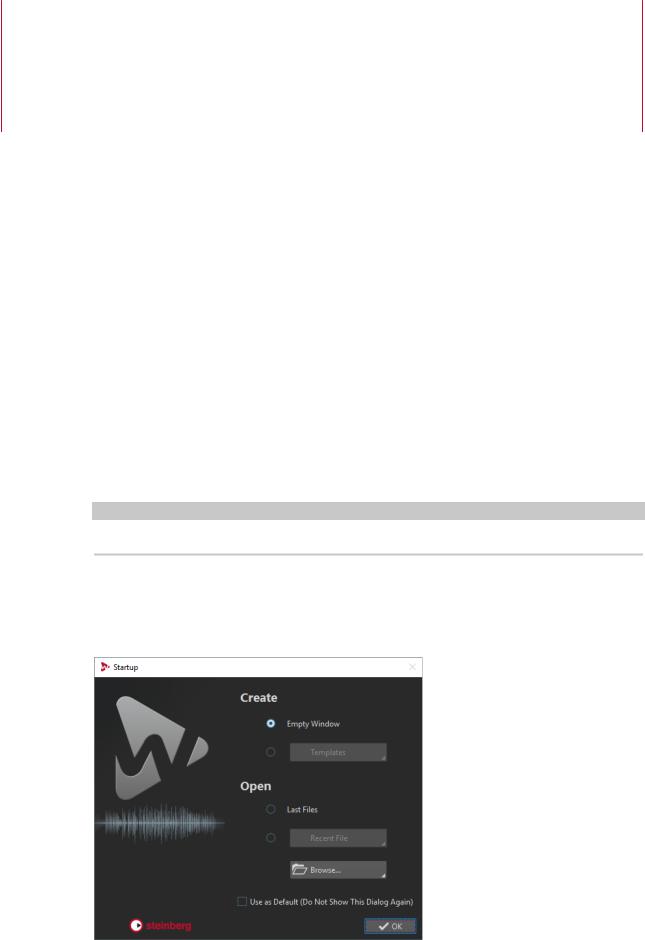
WaveLab Elements Concepts
This chapter describes general concepts that you will use when working with WaveLab Elements. Getting accustomed with these procedures allows you to work more effectively with the program.
General Editing Rules
The common editing operations apply to any Steinberg product.
●To select and move interface items, and to select ranges, click and drag with the mouse.
●Use the keys of your computer keyboard to enter numeric values and text, to navigate lists and other selectable interface items, and to control the transport functions.
●Common operations like cut, copy, paste, or the selection of multiple items can be performed using standard keyboard shortcuts.
NOTE
The behavior of your product is also governed by your preference settings.
Startup Dialog
When WaveLab Elements starts, the Startup dialog opens where you can select which file or template you want to open.
19

WaveLab Elements Concepts
Basic Window Handling
Create
Empty Window
Creates an empty WaveLab Elements window.
Templates
Allows you to open a template in a new project.
Open
Last Files
Opens the files that you last used in WaveLab Elements.
Recent File
Allows you to open a recently used file.
Browse
Allows you to select the files that you want to open.
Use as Default (Do Not Show This Dialog Again)
If this option is activated, the option that you select is used from now on and the startup screen does not open anymore. To display the Startup dialog, even if this option has been activated, press Ctrl/Cmd when starting WaveLab Elements.
Basic Window Handling
WaveLab Elements follows the basic guidelines for the Windows/macOS interface, which means that Windows/macOS standard procedures apply.
Closing Windows
●To close a file tab, click the X button of the corresponding tab or press Ctrl/Cmd-W.
●To close a file tab without saving your changes, hold Ctrl/Cmd-Shift, and click the X button of the tab. This avoids having to confirm a warning message whenever you want to close an unsaved tab.
●To close all file tabs but the selected file tab, right-click a file tab and select Close All But This.
Switching Between Files
You can have multiple files open and switch between them.
●To bring a file to the front, click the corresponding tab.
●To switch between the files, hold Ctrl/Cmd, and press Tab continuously.
●To switch back and forth between the last two active files, press Ctrl/Cmd-Tab. Between each step you have to release all keys.
●To switch backwards, press Ctrl/Cmd-Shift-Tab.
●To toggle between the active file and the last edited file, press F5.
Selecting Audio
Almost all types of editing and processing that you perform in WaveLab Elements operate on the audio selection. There are numerous ways to make an audio selection.
●To select the whole audio file, double-click it. If the audio file contains markers, triple-click it.
20

WaveLab Elements Concepts
Selecting Audio
Selecting a Range by Dragging
The standard way to select a range in the wave window is to click and drag.
If you drag all the way to the left or right side of the wave window, it scrolls automatically, allowing you to select larger sections than what can be shown in the wave window. The speed of the scrolling depends on how far from the wave window edge you are.
Audio Range Selection in an Audio File
You can edit, process, or play back selections of an audio file.
● To access the audio range selection options, in the Audio Editor, select the Edit tab. The following selection options are available in the Time Selection section:
All
Selects the entire waveform.
Toggle
Toggles the selection range on/off.
Extend
Opens a menu where you can select the following options:
●Extend to Start of File extends the selection to the start of the audio file. If there is no selection, a selection is created from the edit cursor position.
●Extend to End of File extends the selection to the end of the audio file. If there is no selection, a selection is created from the edit cursor position.
●Extend to Previous Marker extends the left edge of the selection to the nearest marker to the left or the start of the audio file. If there is no selection, a selection is extended until the previous marker position.
●Extend to Next Marker extends the right edge of the selection to the nearest marker to the right or the end of the audio file. If there is no selection, a selection is extended until the next marker position.
●Extend to Cursor extends the selection to the edit cursor position.
●From Start of File Until Cursor selects the range between the start of the audio file and the edit cursor position.
●From Cursor to End of File selects the range between the edit cursor position and the end of the audio file.
●From Cursor to Previous Marker selects the range between the edit cursor position and the previous marker or the start of the audio file.
●From Cursor to Next Marker selects the range between the edit cursor position and the next marker or the end of the audio file.
●From Playback Position to End of File creates a selection range from the playback position to the end of the audio file. If no playback is taking place, the position of the edit cursor is used.
●From Playback Position to Start of File creates a selection range from the playback position to the start of the audio file. If no playback is taking place, the position of the edit cursor is used.
●Double Selection Length doubles the length of the current selection range.
●Halve Selection Length halves the length of the current selection range.
Channels
Opens a menu where you can select the following options:
●Extend to All Channels extends the current selection range to all channels.
21
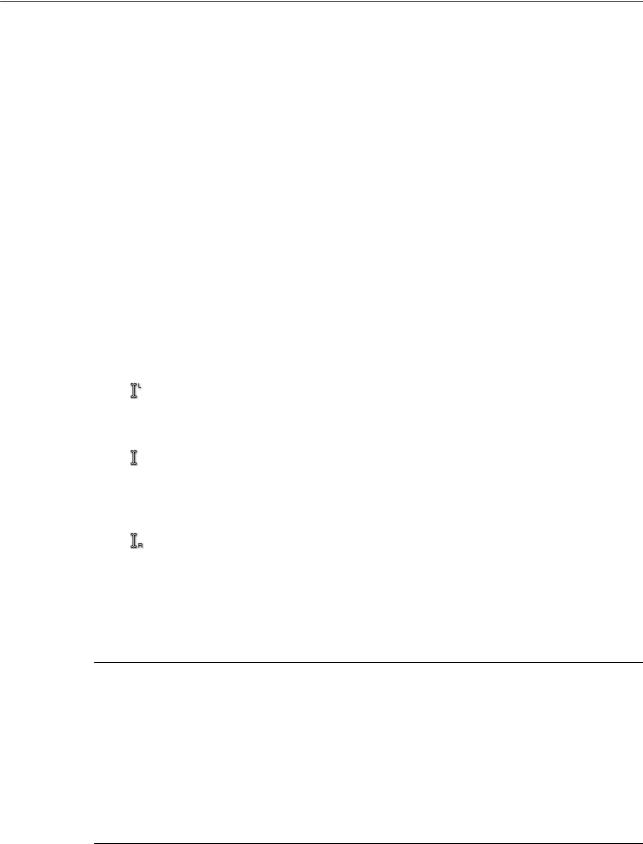
WaveLab Elements Concepts
Selecting Audio
●Left Channel Only reduces the current selection range to the left channel only.
●Right Channel Only reduces the current selection range to the right channel only.
Regions
Opens a menu where you can select the following options:
●Loop Region selects the range between the two loop markers that encompass the edit cursor.
●Generic Region selects the range between the two generic markers that encompass the edit cursor.
Selecting in Stereo Files
If you are working on stereo material in the Audio Editor, you can apply an operation to one channel only or to the entire stereo material.
Which channel is selected when you click and drag in the wave window depends on where you position the mouse cursor. The pointer shape indicates which channel will be affected.
The following pointer shapes are available:
Select left channel
Clicking in the upper half of the left channel selects the left channel.
Select both channels
Clicking in the middle area between the left and the right channel selects both channels.
Select right channel
Clicking in the lower half of the right channel selects the right channel.
Switching the Selection Between Channels
You can switch the channel selection that you have made for a channel to all channels or switch the selection to the other channel.
PROCEDURE
1.In the wave window of the Audio Editor, select a range.
2.Select the Edit tab.
3.In the Time Selection section, click Channels and select one of the following options:
●Extend to All Channels
●Left Channel Only
●Right Channel Only
You can press Tab to switch between the different channel selections.
22
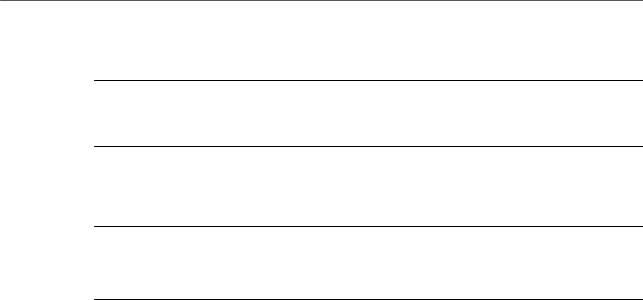
WaveLab Elements Concepts
Selecting Audio
Selecting in the Overview of the Audio Editor
The ranges that you select in the overview of the Audio Editor also apply to the main view.
PROCEDURE
●In the wave window of the Audio Editor, hold down Ctrl/Cmd and click and drag in the overview.
Moving a Selection Range
If a selection range has the correct length, but the wrong position, you can move it.
PROCEDURE
1.In the wave window, hold down Ctrl/Cmd-Shift.
2.Click in the middle of the selection and drag to the left/right.
Extending and Reducing the Selection
You can resize a selection range in the wave window.
There are several ways to extend/reduce the selection:
●Select a range, Shift-click outside the selection range, and drag to the left/right, or click and drag the edges of the selection range to the left/right.
●To extend the selection to the previous/next boundary (marker or start/end of file), press Shift and double-click the non-selected area between the boundaries.
Extending and Reducing the Selection Using the Arrow Keys
●To move the start or end of a selection in the wave window to the left or right, hold down Shift and press the Left Arrow/Right Arrow. To move it in bigger steps, press Page Up or
Page Down.
●To extend a selection to the previous or next boundary in the wave window (marker or start/end of the audio file), hold down Ctrl/Cmd-Shift and press the Left Arrow or Right Arrow.
Deleting Selections
There are several options for deleting a selected range.
Audio Editor
The following options can be found on the Edit tab in the Cutting section.
Crop
Removes the data outside the selection.
Delete
Removes the selection. The audio to the right of the selection is moved to the left to fill the gap.
Audio Montage Window
The following option can be found on the Edit tab in the Removal section.
23
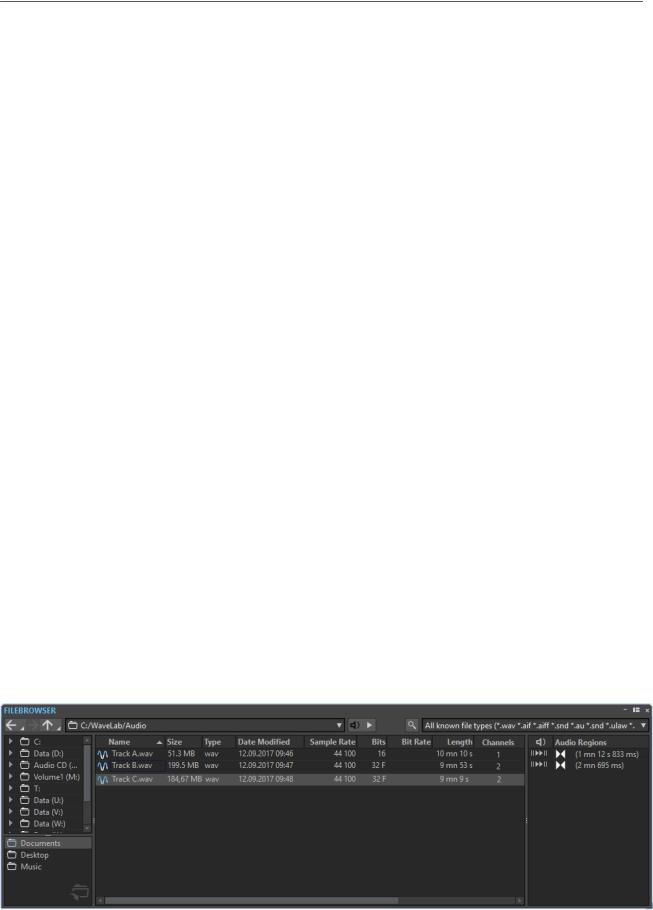
WaveLab Elements Concepts
Sliders
Delete Selected Clip
Deletes the selected clip.
Sliders
At various places in WaveLab Elements, slider controls are available to change parameters. There are a number of ways to change the value of a slider.
●Position the mouse over the slider and use the mouse wheel without clicking. Hold Ctrl/Cmd while using the mouse wheel to scroll faster. This modifier also applies to the zoom wheels. To move a slider, click and drag it.
●To move the slider handle to a position, click the slider at any position.
●To move the slider handle in smaller steps, right-click or click below the handle. Keep the mouse button pressed to automatically step to the next value.
●To reset the slider to the default value, if available, Ctrl/Cmd-click the slider, or click using the third mouse button, or double-click the handle.
Renaming Items in Tables
You can rename items in tables in the Markers window, and in the CD window.
●To rename an item, double-click it or select it, and press Return, and enter the new name.
●To rename the previous/next item, press Up Arrow or Down Arrow. This way you move the focus on the previous/next item, while staying in the edit mode.
File Browser
The File Browser window allows you to browse files from within WaveLab Elements. The Auto Play Mode is useful for speeding up the process of auditioning sound files.
The File Browser window provides you with all the standard browsing functions. It features additional controls to audition audio files and any marker defined regions. You can use it to open or insert files by dragging them to another location.
You can also choose to only view specific file types.
File Browser Window
In this window, you can browse files and open them in WaveLab Elements.
●To open the File Browser window, select Tool Windows > File Browser.
24

WaveLab Elements Concepts
File Browser
Back/Forward/Parent Directory
Allows you to navigate through the list and file hierarchy.
Location
This menu allows you to select a file location to browse and lists the recently used locations.
Auto-Play Mode
If this button is activated, playback starts automatically when you select a file.
Play Selected Audio File
Plays the selected audio file.
Search
If this button is activated, you can enter text in the search field. If it is deactivated, you can search specific file formats.
File type list
Allows you to select which file type and file format to display.
Folder tree
Shows the folders that are available on your computer.
Favorite folders
You can add your favorite folders by dragging them from the folder tree. Each file type has its own favorite folder.
File list
Shows the following information about each file:
●Name shows the name of the audio file.
●Size shows the size of the audio file.
●Type shows the file type of the audio file.
●Date Modified shows the date on which the audio file was last saved.
●Sample Rate shows the sample rate in Hz.
●Bits shows the bit depth in bits. “32F” means 32-bit float and “64F” means 64bit float.
●Bit Rate shows the bit rate in kbps.
●Length shows the length of the audio file.
●Channels shows the number of channels.
Right-click in the file list and select Create Folder to add a new folder for structuring your files.
Audio Regions
If the selected file contains markers, the markers are displayed in the Audio Regions section.
RELATED LINKS
Folders Tab on page 64
25
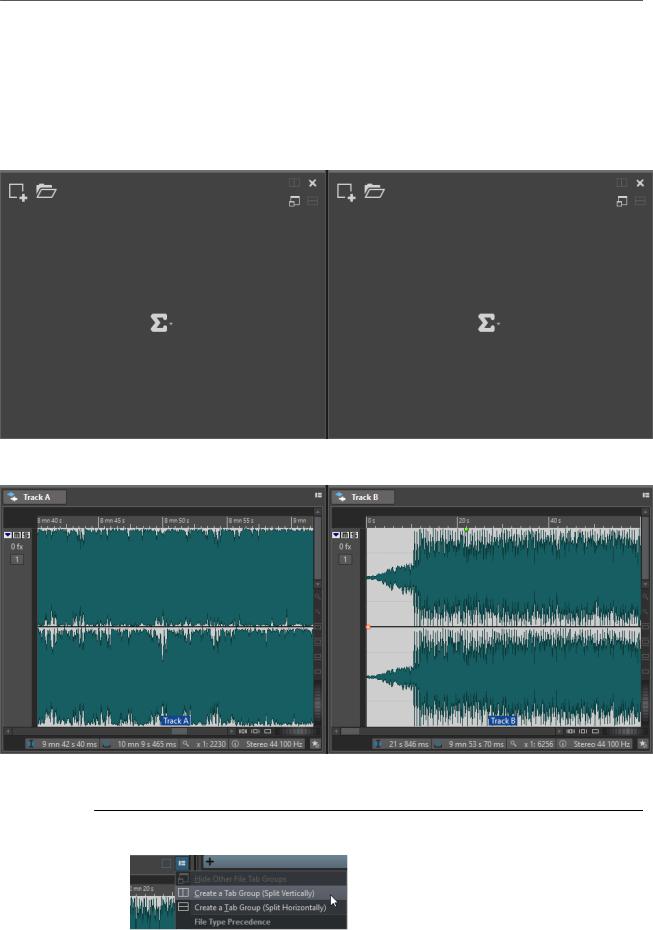
WaveLab Elements Concepts
Tab Groups
Tab Groups
With tab groups, you can view the content of different files, tool windows, or meters at the same time, without having to navigate through different windows. Each tab group has its own content and tab bar.
You can have two file tab groups.
Empty File Tab Groups
File Tab Groups with Audio Montages
Creating File Tab Groups
PROCEDURE
1.In the top right of a file tab window, open the Tab Group pop-up menu.
26

WaveLab Elements Concepts
Peak Files
2.Select Create a Tab Group (Split Vertically) or Create a Tab Group (Split Horizontally).
Creating File Tab Groups in Empty Tab Groups
PROCEDURE
●In the top right of an empty file tab group, click Create a Tab Group (Split Vertically) or
Create a Tab Group (Split Horizontally).
Using Tab Groups
The Tab Group button in the top right of each tab window allows you to maximize, move, and close tab groups. Tabs are used differently depending on the type of window.
Tool Window Tab Groups
●To hide a tool window tab group, open the Tool Window Tab Group Options pop-up menu and select Hide All.
●To reorder tabs in a tab group, drag the tab horizontally to a new position on the tab bar.
●To dock the tab group to another location, open the Tool Window Tab Group Options pop-up menu and select Dock Tab Group Elsewhere. Now you can select where to dock the tab group.
File Tab Groups
●To close a file tab group, click the Tab Group button and select Hide All.
●To reorder tabs in a tab group, drag the tab horizontally to a new position on the tab bar.
●To move a tab to another project, drag the tab to another project.
●To paste the content of a tab into an audio file, drag the tab onto the waveform. The tab is inserted at the cursor position.
●To maximize the active file tab group, open the File Tab Group Options pop-up menu, and select Hide Other File Tab Groups.
To show all file tab groups, open the File Tab Group Options pop-up menu, and select
Show Other File Tab Groups.
You can also double-click the file tab header of a tab group to show/hide other file tab groups.
Peak Files
A peak file (extension .gpk) is automatically created by WaveLab Elements each time an audio file is modified or opened in WaveLab Elements for the first time. The peak file contains information about the waveform and determines how it is drawn in the wave window or the montage window.
Peak files speed up the time it takes to draw the corresponding waveform. By default, the peak file is saved in the same location as the audio file.
27

WaveLab Elements Concepts
Companion Files
Rebuilding Peak Displays
Normally, peak files are automatically updated when the date of the peak file is older than the date of the audio file. However, it can happen that the date of the audio file is not automatically updated. In this case you can force a rebuild of the peak file.
PROCEDURE
1.In the Audio Editor, select the View tab.
2.In the Peaks section, click Rebuild Display.
Companion Files
Companion files (extension .vs) contain Master Section presets and view settings for audio files. If this feature is activated when you save a file, the settings are recreated the next time that you load the file.
Companion files are only available in the Audio Editor. The following view settings are included in companion files:
●Window size and position
●Zoom level
●Scroll position
Storing Companion Files in Another Location
By default, companion files are saved in the same location as the audio file. However, you can select another file location.
PROCEDURE
1.Select File > Preferences > Folders.
2.Click Companion Files and specify another file location.
Processing Precision
WaveLab Elements can load audio samples in many formats but processes them internally as 64bit float samples.
Mixing inside WaveLab Elements is also done in 64-bit float. 32-bit PCM samples can be transferred to 64-bit float and back.
Plug-ins are processed in 64-bit float by default. You can also set the plug-in processing to 32-bit float.
You can set up the processing precision for plug-ins and for temporary files in the Audio tab of the Global Preferences.
NOTE
Processing in 64-bit float means double precision but slightly longer process time than 32-bit float.
Temporary files in 64-bit float have double precision but take longer to read and write than 32-bit float and their file size is twice as big.
28

WaveLab Elements Concepts
Processing Precision
RELATED LINKS
Temporary Files on page 63
Audio Tab on page 277
29

Workspace Window
The Workspace window provides an editing and playback environment for each particular file type. Each environment contains functions that are tailored to the specific purpose of each file type.
●Audio Editor for viewing and editing audio files.
●Audio Montage window for assembling and editing audio montages.
●Podcast Editor for preparing and uploading podcasts.
The Workspace window is highly customizable to match your workflow.
Elements of the Workspace Window
The Workspace window contains the following elements:
●A menu bar
●Tab groups to host the files to edit. You can move the content of a tab to another tab, create a new empty tab, display the file path, and access other functions by right-clicking.
●A set of tool windows. Which tools are available depends on the file type you are working on. The tool windows can be activated/deactivated individually.
Audio Editor
The Audio Editor provides tools and functions for sample-accurate audio editing, high-quality analysis, and processing.
The Audio Editor includes various metering tools.
The wave window gives you a graphical representation of the audio file and allows you to view, play back, and edit the file.
RELATED LINKS
Audio File Editing on page 79
Audio Montage
In the Audio Montage, you assemble audio clips into a montage. You can arrange, edit, and play back clips on both stereo or mono tracks.
Features include both trackand clip-based effects, volume and pan automation, and wideranging fade and crossfade functions.
You can place any number of clips on an audio track. A clip contains a reference to a source audio file on your hard disk, as well as start and end positions in the file.
The montage window gives you a graphical representation of clips on tracks. In it you can view, play back, and edit the tracks and clips.
30
